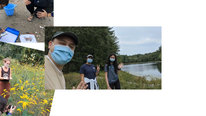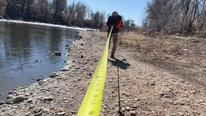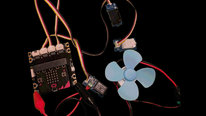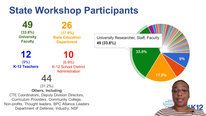- Meredith Kier
- Associate Professor
- Presenter’s NSFRESOURCECENTERS
- William & Mary
- Esther Boachie
- Computer Engineering Sophomore
- Presenter’s NSFRESOURCECENTERS
- Virginia Tech
- Lindy Johnson
- Associate Professor
- Presenter’s NSFRESOURCECENTERS
- William & Mary
- Brandie Wright
- Technology Education Teacher
- Presenter’s NSFRESOURCECENTERS
- Newport News Public Schools, Dozier Middle School
New possibilities for broadening the impacts of middle school engineering thr...
NSF Awards: 1932739
2021 (see original presentation & discussion)
Grades 6-8
This video features an exploratory research and design study that investigates how middle school teachers and STEM undergraduates collaborate to promote culturally responsive engineering teaching. Dr. Meredith Kier and Dr. Lindy Johnson, from William & Mary, describe the rationale of the undergraduate-teacher partnership and explain how digital tools can promote middle school students' engagement in engineering design problems. Teacher Brandie Wright, from Newport News Public Schools, and undergraduate engineering major Esther Boachie, from Virginia Tech, share how they engaged students in the design process virtually online, while schools were closed due to Covid-19. Brandie and Esther show how middle school students used music, computer science, and entrepreneurship to promote racial equity in a virtual space. Together, they describe how students decoded musical messages of injustice and created their own tempo for equity.
Related Content for Collaboration Dynamics and Culturally Responsive Teaching
-
 2019Creating a STEM evaluation community of practice
2019Creating a STEM evaluation community of practice
Rodney Hopson
-
 2018The Road to Persistence in STEM: HBCUs in Action
2018The Road to Persistence in STEM: HBCUs in Action
Shabnam Brady
-
 2020Student Ownership and Investment in Laboratory Settings
2020Student Ownership and Investment in Laboratory Settings
Dermot Donnelly-Hermosillo
-
 2015Synthesizing Computer-based Scaffolding
2015Synthesizing Computer-based Scaffolding
Brian Belland
-
 2021Equity for STEM faculty through policy change
2021Equity for STEM faculty through policy change
Meredith Redlin
-
 2021STEMMING the Tide in STEM
2021STEMMING the Tide in STEM
Katherine Picho-Kiroga
-
 2019ASK: Applying Scientific Knowledge
2019ASK: Applying Scientific Knowledge
Jason Deibel
-
 2018Access to Knowledge Assets: Making PCK Available to Teachers
2018Access to Knowledge Assets: Making PCK Available to Teachers
Patrick Smith
Playlist: ITEST Videos Playlist
-
 2021Socially-Distanced Community Conservation Partnerships
2021Socially-Distanced Community Conservation Partnerships
Nicole Freidenfelds
-
 2021CryptoComics - Cryptology and Cybersecurity for Kids
2021CryptoComics - Cryptology and Cybersecurity for Kids
Christine Wusylko
-
 2021Stories of Algebra for the Workplace
2021Stories of Algebra for the Workplace
Candace Walkington
-
 2021Empowering Students in Math Through Entrepreneurship
2021Empowering Students in Math Through Entrepreneurship
Erin Krupa
-
 2021Inventing Designing and Engineering for All Students
2021Inventing Designing and Engineering for All Students
Wendy Martin
-
 2021The Human Body in P6 STEM Teaching: The BODYMODELS Project
2021The Human Body in P6 STEM Teaching: The BODYMODELS Project
Neal Grandgenett
-
 2021Our Experiences with Game Based CRC, Esports, and the Future
2021Our Experiences with Game Based CRC, Esports, and the Future
Mark Van Auken
-
 2021iSTEM-Xe: Implications of COVID-19 on the Black Community
2021iSTEM-Xe: Implications of COVID-19 on the Black Community
Shannon Jolly
-
 2021Interest Stereotypes Cause Gender Gaps in STEM Motivation
2021Interest Stereotypes Cause Gender Gaps in STEM Motivation
Marley Jarvis
-
 2021Voices to Hear
2021Voices to Hear
Shakuntala Gopal
-
 2021Challenger Center Classroom Adventures
2021Challenger Center Classroom Adventures
Lance Bush
-
 2021Chief Science Officers Go Virtual
2021Chief Science Officers Go Virtual
Kelly Greene
-
 2021Billion Oyster Project Curriculum and Community Enterprise
2021Billion Oyster Project Curriculum and Community Enterprise
Dr. Lauren Birney
-
 2021Catalyzing Inclusive STEM Experiences: Tune in for Equity
2021Catalyzing Inclusive STEM Experiences: Tune in for Equity
Lara Hebert
-
 2021Super Fun Science of Music Hands-on Online Tools.
2021Super Fun Science of Music Hands-on Online Tools.
Victor Minces
-
 2021Impact of a Family-Community-University Engineering Project
2021Impact of a Family-Community-University Engineering Project
Amber Simpson
-
 2021SPIKEY-20: A Virtual Epidemic for Connecting with COVID-19
2021SPIKEY-20: A Virtual Epidemic for Connecting with COVID-19
Yasmin Kafai
-
 2021GaleForce: Girls Immersed in Robotics Learning Simulations
2021GaleForce: Girls Immersed in Robotics Learning Simulations
Beryl Hoffman
-
 2021My STEM Story: Students Explore Science Identities
2021My STEM Story: Students Explore Science Identities
Ed Madison
-
 2021COVID-Inspired Data Science for Youth
2021COVID-Inspired Data Science for Youth
Jan Mokros
-
 2021Engineering Design for Rural Middle School Students
2021Engineering Design for Rural Middle School Students
LaTricia Townsend
-
 2021SEBA: STEM Engagement Through Mentoring
2021SEBA: STEM Engagement Through Mentoring
Rick Greer
-
 2021Engineering WINS
2021Engineering WINS
Jacqueline Genovesi
-
 2021Developing Middle School Students' AI Literacy
2021Developing Middle School Students' AI Literacy
Helen Zhang
-
 2021Collaboration Dynamics and Culturally Responsive Teaching
2021Collaboration Dynamics and Culturally Responsive Teaching
Meredith Kier
-
 2021Sustaining a STEM Learning Ecosystem During a Pandemic
2021Sustaining a STEM Learning Ecosystem During a Pandemic
Denise Nacu
-
 2021Internships for Underrepresented Students Amid the Pandemic
2021Internships for Underrepresented Students Amid the Pandemic
Lynda Gayden
-
 2021Place-Based Data Literacy: Protecting the Platte
2021Place-Based Data Literacy: Protecting the Platte
Samantha Schall
-
 2021Embodied Coding in Augmented and Virtual Reality
2021Embodied Coding in Augmented and Virtual Reality
Ying Wu
-
 2021WeatherBlur: student initiated citizen science program
2021WeatherBlur: student initiated citizen science program
Rebecca Clark Uchenna
-
 2021Enabling Opportunity: Bridging Science & Physical Computing
2021Enabling Opportunity: Bridging Science & Physical Computing
David Jackson
-
 2021Helping States Plan to Teach AI in K-12
2021Helping States Plan to Teach AI in K-12
Christina Gardner-McCune
-
 2021RPPforCS: Research Practitioner Partnerships across K-12
2021RPPforCS: Research Practitioner Partnerships across K-12
Rebecca Zarch
-
 2021Keeping the focus on dimensions of quality math discourse
2021Keeping the focus on dimensions of quality math discourse
Paola Sztajn
-
 2021Building Community to Shape Emerging Technologies
2021Building Community to Shape Emerging Technologies
Judi Fusco




Meredith Kier
Associate Professor
Welcome to our video describing a collaborative partnership between faculty at William & Mary, middle school teachers in Newport News Public Schools, and undergraduates from university chapters of the National Society of Black Engineers. We would love to hear your ideas, questions, and feedback on our project through the following questions:
1) What potential do you see for the use of the engineering design notebooks in classroom partnerships?
2) How have you seen engineering effectively integrated into mathematics and science classes with a standardized curriculum and testing?
3) What factors do you find to be particularly powerful in partnership work?
4) What are other partnership models in schools that show promise for promoting culturally relevant STEM education?
Kwame Owusu-Daaku
I love, love, LOVE this project! Thought not an engineer, I think the scaffolded approach and the opportunity to write things down and reflect is key for knowledge retention and application. I can speak a bit to question 3 but I think relatability or the ability to identify with a partner is a key tool for the success of a partnership. I think in any partnership one or more members need to know that they are at very least heard, if even not understood, by another.
Kimberly Elliott
Meredith Kier
Associate Professor
Thank you so much for your feedback, Kwame. I agree with you. We currently have a manuscript being revised that speaks to exactly this. It’s a combination of matching identities (and a student focused teaching philosophy) and willingness to enact strong collaboration skills that makes these partnerships work.
Kwame Owusu-Daaku
Kwame Owusu-Daaku
Meredith! So great to hear! I look forward to reading the manuscript when it is published!
Heidi Carlone
Distinguished Professor
Hi Meredith. I love seeing this project come to life. What a powerful way to connect stakeholders in culturally relevant engineering education, and I've never seen virtual notebooks as a mentoring model-- super creative. I'm wondering: How do you, the middle school teachers, and the college students come to a shared understanding of the college student mentors' roles? What kinds of support do they get to enact those roles? In other words, do they engage in professional learning re: their roles? I ask because we've found that the college students' roles in our project were CRITICAL in promoting middle school students' affiliation with the project activities.
Jennifer Kidd
Hi Meredith and team!
Kristie Gutierrez told us about your project. Can you share a little more? How often did the teams meet with each other and with the middle schoolers? Were they working with middle schoolers individually or as a class. In school, out of school? Sounds like a great collaboration!
Meredith Kier
Associate Professor
Hi Jennifer! The undergraduates worked with students during the school day and the amount of time greatly varied by partners. For example, we had one undergraduate come to their science teacher’s classroom 22 times from October-April. Others visited 6 times. Undergraduates also communicated with them through the design notebooks. Any time students wrote in them, undergrads would respond and provide feedback to the particular stage. The undergraduates and teachers planned together formally for 20 hours and informally about 5 hours. Thanks so much for your help question and I would love to collaborate with you and Kristie:)
Meredith Kier
Associate Professor
Hi Heidi! Thanks so much for your kind words. Your question is an important one and actually was a driving question of this exploratory study [EAGER grant]. We wanted to figure out how collaboration dynamics played out between the partnerships, and what practices teachers and undergraduates naturally drew upon when working together to establish clear roles in the planning and implementation of engineering. We provided teachers with time to plan, common district-wide language and norms around engineering practices, and tools to organize their design task and implementation schedule. However, we did not provide training on defining roles because we wanted to compare the 6 partnerships first to see what practices could be leveraged in future professional development. We are currently working on revisions to a manuscript for Urban Education about this that details three different cases of collaborations and how the teacher and undergraduates leveraged expertise and power dynamics to define their roles in the classroom and push the bounds of culturally relevant education in science and mathematics classrooms. I can send you this draft soon. From our data analysis though, we found that our mentors need clear guidance on how to engage with students around the different engineering practices. We have an ITEST grant, in review, that defines key literacy strategies that will be used to support engineers to define their roles. This includes having the undergraduates practice think-alouds around their own design thinking in an effort to model their thinking about engineering problems to students, providing critical and interactive feedback, and communicating solutions to broader audiences. We will be piloting some of these strategies this summer in an out-of-school camp to see how the professional development for mentors on engineering literacies supports a clearer role in their partnerships with teachers.
Heidi Carlone
Daniel Damelin
Senior Scientist
I love the idea of student-to-student mentoring/collaboration. Was this a one-to-one type setup or did one undergraduate work with several students?
The multimedia notebook also sounds intriguing and a great idea for supporting the interaction between mentor and mentee. In what other ways did the participants connect with each other?
Also wondering what some of the final design projects looked like. Is there a place one could see some of them?
Brian Gane
Kimberly Elliott
Dr. Julia V. Clark
Retired Federal Employee
This is a project that has merit and can be considered transformative. It uses engineering design to create authentic learning experiences for young children in the classroom through partnering undergraduate students of color with classroom teachers. The presence of these undergraduate engineering students in the classroom encourages the young children to see themselves as engineers, as well as helping them recognize the role of engineers in society. The partnership with the undergraduate students is a great way to reach new populations of students who may be interested in studying engineering in college. The decoding aspect of the engineering design creates authentic learning experiences for the young children. I like this project very much.
Kimberly Elliott
Meredith Kier
Associate Professor
Dr. Clark, thank you. You may not remember this but we met at an ITEST summit several years ago to discuss some of these ideas (I used to work at Howard prior to William & Mary). I particularly remember your enthusiasm about the role of the undergraduates from university NSBE chapters in STEM classrooms. We currently have an ITEST in review to understand how literacy strategies (e.g. think-aloud, sentence frames, and modeling explanations) can support the professional learning of mentors to play a larger role in the classroom alongside math and science teachers. Your advice has supported the transformation of some of this work, and I am grateful.
Marion Usselman
Hi Merideth,
Thanks for a great video. We love seeing EarSketch and the Amazon competition featured. It is exciting.
I want to address your first and second questions, about integrating engineering into math and science and using engineering notebooks. The AMP-IT-UP project, which was funded by a large NSF Math/Science partnership grant, created semester-long middle school engineering courses (named STEM-ID courses), and parallel 1-week math and science modules. You can see a variety of videos about it in the video multiplex from past years. We have published research data about the effect that the engineering course had on students' math and science standardized test scores. Students were put into the courses randomly, and those who had STEM-ID courses at least twice in middle school showed very significant increases in their 8th grade math and science test scores. (Alemdar, M., J. Gale, J. Lingle, R. Moore, J. Rosen, M. Usselman. (2018) The Impact of a Middle School Engineering Course on Students’ Academic Achievement and Non-cognitive Skills, International Journal of Education in Mathematics, Science, and Technology).
We want to scale up the STEM-ID courses and are definitely looking for partners. One component of the STEM-ID courses is an electronic Engineering Design Process Log. A video describes it at https://mediaspace.gatech.edu/id/1_lfuu1y25?wid... We would love to talk about how it has been used.
Brandie Wright
Roxanne Moore
Lindy Johnson
Meredith Kier
Associate Professor
Thank you for your feedback and for sharing your process log. I would love to discuss this with you. I'm wondering, Marion--can you speak to the quality of documentation you received from students in this log? We have really been working on literacy strategies to support clear scientific and engineering communication and I'm seeing a lot of convergence with this work.
Roxanne Moore
Hi Meredith!
So great to see Your Voice is Power in action!! Love the way you formatted the notebook content. I lead the Amazon-EarSketch partnership at Georgia Tech and would love to connect with you. I would value your insights on the curriculum and would be happy to discuss future collaboration. I was also an architect of the Engineering Design Process Log described by Marion, above, and am very keen on making engineering design and its documentation accessible to students. I believe we can provide better feedback to students (more timely, lower stakes, less embarrassing if the student doesn't feel successful) by using technology to enhance these tools.
Brandie Wright
Meredith Kier
Associate Professor
Roxanne, thanks so much for reach out. I would love the opportunity to brainstorm with you around this. In addition to the need for quality feedback, these spaces provide such rich insight into students thinking. Feel free to reach out to mwkier@wm.edu.
Brian Gane
Great project and video!
Ms. Wright and Ms. Boachie, I noticed the "OUTKAST framework" under the Layers of Injustice section. Can you say more about this framework/model and how students responded to or used it?
I think this is a great project to use music and social justice as entryway into engineering and computing. I wonder, did you also see the effect in the opposite direction? Did you have students that were already into engineering and computing but then learned to leverage those skills to express themselves musically?
Brandie Wright
Technology Education Teacher
Hello Brian,
The OUTKAST Imagination Framework was developed by Dr. Jocelyn Wilson, professor of Hip Hop Studies and Digital Humanities in the School of Literature, Media, and Communication at Georgia Tech. Dr. Wilson is a scholar in Black Media Studies and she created a framework to help her students decode song lyrics to find the true meaning of an artist’s lyrics. This framework is called the Outkast Imagination.” It was inspired by her love of HipHop culture and deep appreciation for the influences and foundational principles of hiphop.
I have been pleasantly surprised at the connections the students made to this framework. We used it to analyze the lyrics in the Decode the Message and Layers of Injustice sections. During class, we listened to the verses and discussed which element of the framework did they associate with the lyrics.
One of the strongest parts of this project is the reach for all students. For those students that had some computing experience, they jumped straight into Earsketch and even created songs outside of class. Also, those students that already wrote music loved the connection between coding and music creation.
Brian Gane
Brian Gane
Thanks for all the information about the OUTKAST imagination framework, I'll look into it more. It's great to hear such positive results from your students' experiences with using the framework and with using Earsketch!
Natalia Yanez Castillo
This is a great project! It is crucial that all students, particularly the ones who have been historically marginalized feel seen, included, value, and know that their VOICES HAVE POWER!!
Monica Cardella
Thank you for your work on this project and thank you for creating this video and sharing your work related to mentoring in STEM classrooms and collaborative relationships. I enjoyed hearing about Ms. Wright and Ms. Boachie’s collaboration!
Further posting is closed as the event has ended.